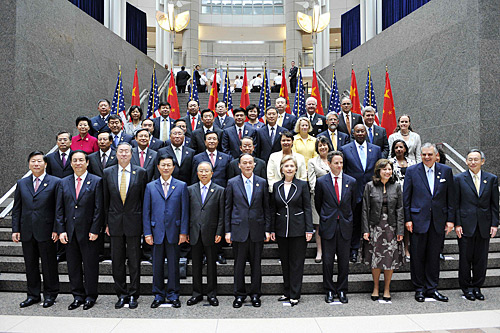|
 |
|
BIG UNION: Officials pose in Washington, D.C. on July 27 at the opening of the China-U.S. Strategic and Economic Dialogue (ZHANG YAN) |
"Yes, we can" was the mantra of the campaign that made Barack Obama the 44th President of the United States this year. Chinese State Councilor Dai Bingguo repeated that now famous catchphrase in Washington, D.C. when addressing the opening ceremony of the first round of the China-U.S. Strategic and Economic Dialogue (S&ED) on July 27.
Upwards of 150 top Chinese and U.S. officials attended the two-day talks aimed at advancing a "positive, cooperative and comprehensive relationship" between the two countries. Special envoys Dai and Chinese Vice Premier Wang Qishan co-chaired the S&ED together with their American counterparts, including U.S. Secretary of State Hillary Clinton and Secretary of the Treasury Timothy Geithner.
Topics ranged from promoting China-U.S. relations, deepening economic and financial ties, addressing climate change and clean energy issues to tackling development and security challenges.
Despite differences and conflicting interests, the fact that China and the United States were even able to undertake such a major dialogue signifies great progress that will surely enhance mutual understanding, according to Chinese and U.S. government officials and international studies experts.
Building on the past
The S&ED represents the "marriage under one umbrella" of two previous high-level dialogues begun under the Bush administration, said Charles W. Freeman, a China expert who runs the Freeman Chair in China Studies at the Center for Strategic and International Studies in Washington, D. C.
Under the new mechanism, the Strategic Dialogue, formerly held at the vice-ministerial level, has now been upgraded to the cabinet level, noted Drew Thompson, Director of China Studies and Starr Senior Fellow at The Nixon Center in Washington, D.C.
Thompson believes China has been the "bright spot" in the Bush administration's foreign policy, and that the Obama administration will build on its success. "I think Bush handled China relations very well—particularly in his second term," he said. "Obama's team is capitalizing on that, and trying to take it to the next level."
Upon their first meeting in April on the sidelines of the 2009 G20 London summit, Chinese President Hu Jintao and Obama charted the future course of China-U.S. relations by agreeing to work together to build a "positive, cooperative and comprehensive relationship" in the 21st century. They also agreed to create the S&ED to replace the China-U.S. Strategic Dialogue and the China-U.S. Strategic Economic Dialogue, initiated respectively in 2005 and 2006.
As a result, the S&ED now consists of both a strategic track and an economic track.
At the first round of the S&ED, Chinese and U.S. officials stressed that high-level contacts play an "irreplaceable role" in developing China-U.S. relations, as they confirmed Obama's visit to China this year, according to a joint press release the two countries issued after the dialogue.
| 
